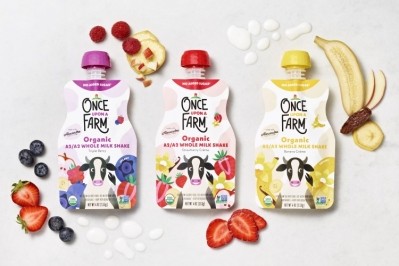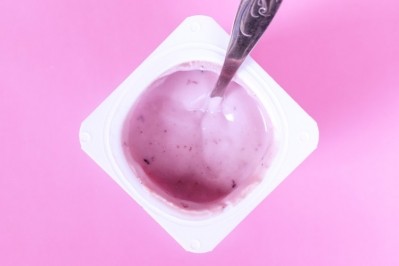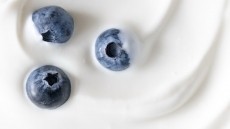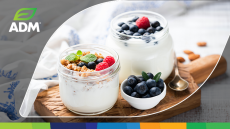Flavor and color trends in dairy: Predictions for 2024
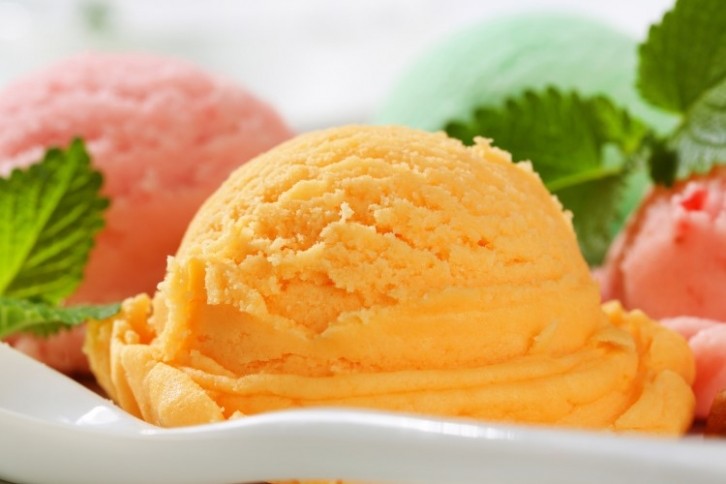
You have probably heard – and then heard it again – that Pantone announced Peach Fuzz as its 2024 color of the year. Pantone says the color, a hue that sits between pink and orange, ‘inspires belonging, recalibration, and an opportunity for nurturing’. Technology companies and fashion houses have already caught on the new trend, and its influence is likely to spill into food this year.
From peach to purple
Flavor houses have been revealing their own trends in recent weeks, and some, such as dsm-firmenich, have echoed Pantone’s bet. According to the company’s proprietary consumer study, which measures emotions associated with ingredients, peach is unique in its contrasting qualities – being both indulgent and pampering, youthful and nostalgic.
For dairy product manufacturers – particularly those specializing in desserts and flavored dairy – this could be an opportunity to introduce new or limited-edition flavors that tap into the new trend. According to Euromonitor International, limited-edition products that feature vibrant designs will continue to hit the market, as consumers favor products that elicit positive emotions as a counterpoint to a reality marred by political unrest and climate emergencies.
“Ice creams and frozen treats in particular lend themselves well to flavor exploration,” Hélène Moeller, vice president, global product marketing, flavors and colors at ADM, told DairyReporter. “In fact, 71% and 68% of consumers in North America and EMEA, respectively, like limited edition flavors in ice cream.”
“According to a Mintel report, global dairy product launches in 2023 included floral fruit flavors like peach, blueberry and lychee; the sweet floral quality of honey – standalone and paired with fruits; nuts with indulgent flavors; and the tropical profiles of papaya and passionfruit rolling into flavor combinations,” she added. “There was also a move toward sumptuous purples in taro and ube, varying shades of blue for fancifully-named flavor concepts, and earthy green hues for pistachio and matcha. Further, coconut became a standalone both for flavor and format (milk/yogurt base or alternative coconut milk base).”
Peach also lends itself well to flavoring drinkable yogurts as well as kefir, and could add variety to ranges that typically bet on more popular fruits such as strawberry and raspberry. In ice cream and dairy desserts, it could also work well with herbs, such as raspberry, for those formulators looking to tap into the botanicals trend.
Sharp and sweet flavor combinations are on the rise, according to Moeller: “We saw this come to life with lemon accents (lemon curd, preserved lemon), florals (elderflower, orange blossom) with honey, and citrus in combinations with herbs and savory notes,” she told us. “Blueberry in various savory dairy products, from stilton cheese to goat cheese, cream cheese and cottage cheese, also garnered attention.”
Speaking of escapism, consumers will continue to seek an outlet for the stressors caused by the global political and economic turbulence. Euromonitor research revealed that 73% of consumers who struggle with stress and anxiety say these issues impact moderately or severely on their everyday lives. This remains a sustainable trend, with Mintel research from October 2022 tracking Gen Z consumer perceptions having also revealed that 72% of younger shoppers think it’s hard not to be anxious about the future, with 62% finding their day-to-day lives stressful. And so, creating products that can contribute to alleviating common daily stressors could go a long way to establishing sustainable consumer relationships. This could combine positive messaging and bold branding – without overdoing it – says Euromonitor.
Besides peach, there’s another frontrunner in the race for flavor of 2024. Back in 2012, Mintel predicted that ‘purple foods’ – rich in antioxidants in addition to their visual appeal – were the next big thing. Come 2019, Mintel recorded a 126% increase in purple-colored food and drink products launched globally between 2012 and 2018. Being both ‘instagrammable’ and healthy whilst also geared towards clean label formulations, purple has appeared in drinkable and traditional yogurts and kefirs as well as ice cream. This year, several flavor houses such as T. Hasegawa have predicted that ube – a type of purple root vegetable that hails from the Philippines – will be 2024’s top flavor trend. “This vibrant and unique purple yam, native to Southeast Asia, has been making waves in the culinary world and it’s easy to see why,” the company says.
Similar to other root vegetables such as sweet potato, ube - pronounced ‘oo-beh’ - has a nutty, sweet and earthy flavor profile, making it equally at home in desserts and savory foods.
Rich purples, as well as reds, pinks, blues, yellows and earthy greens could also be a hit this year, according to ADM. “As identified in our 2024 Flavor & Color Trends report, consumers are unapologetically choosing flavors and colors that represent their personal lifestyles. From leaning into luxurious eating experiences to seeking reinventions of nostalgic products and transcending traditions and geographic boundaries, the new year presents both dairy and alternative dairy brands with an opportunity to create captivating products that appeal to consumers’ unique desires,” Moeller told us.
“Although affordability is top of mind, consumers still want moments of luxurious self-expression. Velvety indulgence goes hand-in-hand with dairy offerings like Italian pistachio ice cream or jasmine-flavored yogurt.”
“We also see this coming to life through umami-infused dairy-based sweets that include unusual flavor pairings, such as raspberry and parmesan, pistachio and grilled corn, and even cassava with orange blossom. These profiles play well with a wide spectrum of colors, particularly muted greens, soft pinks, vibrant reds and warm browns. Indulgence can also help capture consumer interest in alternative dairy products.
“Alternative dairy manufacturers that capitalize on the notes of plant-based ingredients like oat, almond and rice, pairing them with salted caramel, coffee or banana, may find new avenues of innovation.”
The rise of ‘functional’ continues
With physical and mental wellness set to be a dominant focus for consumers in 2024, according to Euromonitor, which suggests that providing consumers quick and effective solutions that enhance their bodies and mind while easily blending with current habits can be key. Functional ingredients can be crucial to enhancing the health benefits of dairy, so what have been some of the trends that have been growing in popularity?
According to SPINS’ 2024 CPG Trends report, cinnamon, beetroot and bee propolis are among the functional ingredients experiencing high growth. This is usually an indication that these ingredients could soon expand to other categories besides supplements, such as food. At the same time, SPINS highlights that macro nutrition will remain important to consumers – its research suggesting that some consumers are counting macros more than overall calories. High-protein dairy products are already popular with shoppers, with new products, such as the recently-released Yoplait Protein, continuing to debut in 2024.
Digestive health will continue to be top of the mind, with SPINS stating that the trend will likely find new applications, categories and shoppers in 2024, including gut-friendly foods, with yogurts containing 6g of fiber or more poised to grow 30% this year.
ADM's Moeller told us: "Certain dairy products, such as Greek yogurt, already present a health halo for their perceived wellness attributes. In the new year, we predict the emergence of more unique offerings such as funky and fermented flavors, which may also cue consumer association to digestive health. Sour notes deliver a twist on dairy products, like a balsamic strawberry ice cream or a blueberry kefir drink.
"Citrus also remains popular for its association with products that support immune function. With traditional orange, lemon and lime, along with emerging varietals, such as yuzu, finger lime, calamansi and blood orange, dairy brands can lean on citrus to appeal to consumers’ evolving demands. Think blood orange creamsicle-flavored yogurt or finger lime and plum dairy-based smoothie."
She added that white remains a crucial color for dairy and alternative dairy brands. "Not only does it help communicate freshness and purity across products like yogurts, but it also elevates dairy alternatives to better match their traditional counterparts. Plus, our research shows that 57% of consumers associate white with products that support bone and joint health, appealing to consumers’ evolving wellness demands. "
